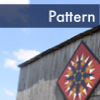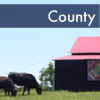Quilt Pattern
Little Dutch Girl and Boy
MAIN INFORMATION
The original mill was powered by a sixteen-foot high, wooden, overshot, water wheel. This wheel was connected by dogwood trunnel-head gearing to two fifty-four inch diameter stone buhrs - one stone for grinding corn and one for grinding wheat. Beef and mutton tallow were produced on the farm to lubricate the gears and bearings. George W. St. John acquired the mill in 1866 from relatives. The Watauga valley was very prosperous, having been spared damage from the Civil War. Milling continued to flourish as it had for the past century and the area became known as "The Bread Basket of the Southeast". Railroad and water transportation were an asset to the mill and goods from the St. John Mill were shipped all over the region. In busy seasons, wagons lined up overnight to grind their grain.In 1904, James St. John inherited the mill and farm from his father. For many years, James operated the mull supplying the large stores in the area with flour and grain and doing custom milling on an individual basis. His son George St. John, an electrical engineer by profession, purchased the mill and improved the operation by converting the power source from water to electricity and modernizing the equipment. Today, the mill is owned by George St. John's daughter and son-in-law, who are continuing the family business. The emphasis of the mill operation has changed from a general feed and milling business to a feed and seed store. The mill now specializes in all aspects of farm needs, from feed grains to pet food and veterinary supplies. The St. John Mill has existed for over 200 years, and with the support of the family and loyal customers, the business will continue into the next century. The 'Little Dutch Girl and Boy' Quilt Square was painted by Ron Dawson.

CONTACT INFORMATION
Watauga, Tennessee
423-928-5841
LOCATION MAP
36.3692 °N, -82.3051 °W






